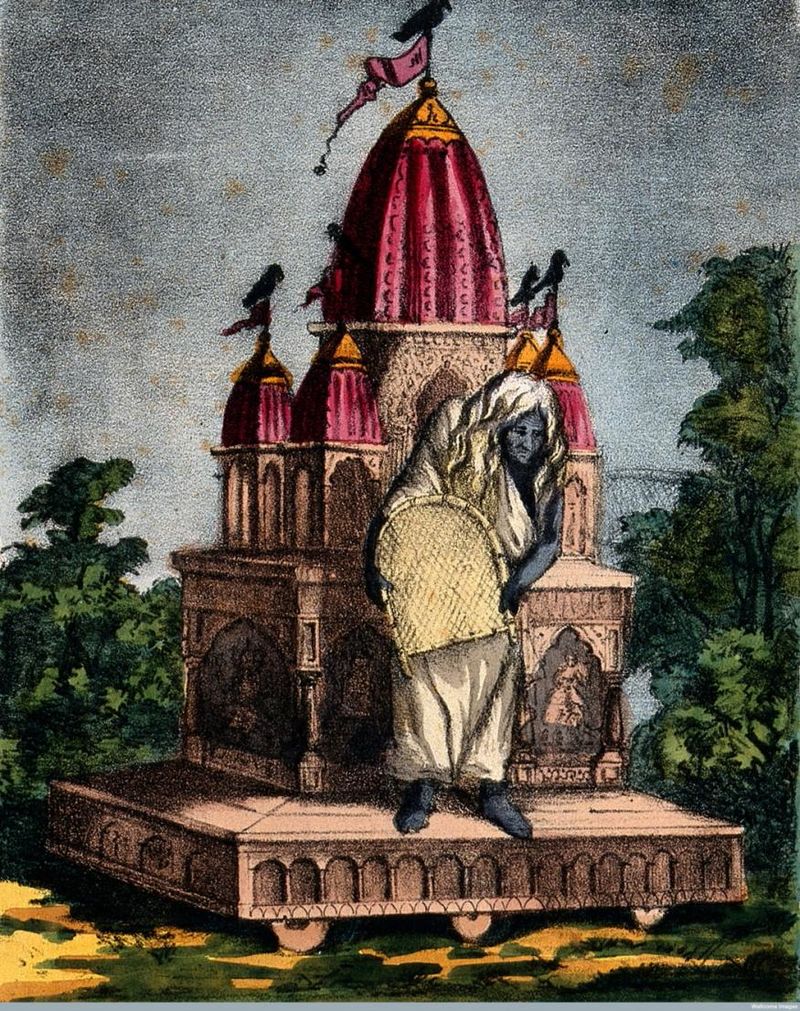 Submitted by Krishna on
Submitted by Krishna on

wikipedia.org public domain
The Tantric goddess Dhumavati is an ugly, withered widow with sagging breasts, huge ears, a long nose, and crooked teeth. She carries a skull, a sword, a winnowing basket, and even a broom like a stereotypical old witch. She wears dirty rags for clothes and snakes for bracelets, and one of her texts (the Prapancasara samgraha, quoted in David Kinsley’s Tantric Visions of the Divine Feminine) says her complexion is like “the black clouds that form at the time of cosmic dissolution.” She is always hungry and thirsty, and sits on an empty carriage led by a crow. She cackles with glee.
Dhumavati first appeared when the goddess Sati threw herself on her father’s ritual fire after he insulted and disrespected her gravely. In so doing, she threw the universe into chaos. Dhumavati, who feeds on our most painful emotional moments, manifested as the smoke from Sati’s suicidal fire.
In another story, Sati is hungry and asks her husband, Shiva, for food. He refuses, telling her to wait for him to finish meditating. Hours pass, days, and Sati becomes ravenous. She keeps asking Shiva to feed her and he keeps ignoring her. Finally she gives up waiting and swallows her husband in one gulp. He frees himself from her belly, infuriated, and curses her as Dhumavati, the eternal widow and husband-killer. She cackles, having found a way to satisfy herself without him.
Dhumavati is not a widely beloved figure in India. As the goddess of widows, she is feared and hated by many. In many places in India, widows are cast out of society, their heads shaved in a sort of imposed ugliness. Sati’s self-sacrifice has been cruelly translated into the real-life practice of suttee, where women throw themselves on their husband’s funeral pyres. Some people call widows “husband eaters.” Dhumavati is the goddess of mistreated, rejected, grief-stricken widows.
And yet she cackles.
In a patriarchal society where men are in power, women must stay powerless. Widows step outside of this system—without a husband, they cannot be a wife. They do not occupy a role that is useful to the patriarchal ordering of things. They could be independent. They could be powerful. They could learn to feed themselves.
Widowhood is more complicated in India than in the West, and I do not mean to minimize or simplify the plight of widows in a culture that’s not my own. I do suspect, however, that these strange Tantric goddesses represent some sort of secret feminine power that has been suppressed or forgotten. That suppression is hardly unique to India.
People of all genders know what it’s like to have to perform a certain role in society. In the West, men must be rich and strong and never show weakness or vulnerability. Women must be, primarily, young and pretty. Have you ever noticed the phrase “You are beautiful” popping up on social media feeds or in women’s bathrooms? The message is double-edged: it implies that beauty is your most important attribute, and that if you didn’t have it, you would be worthless.
Dhumavati’s ugliness, age, and widowhood, the very qualities for which people fear her, free her. She does not have to play a game whose rules have been written by someone else. She drags an empty carriage not because she has nothing, but because she is not carrying anyone else’s baggage. She wears her ugliness like a brilliant crown, clearly the queen of her own domain. So how can we, with Dhumavati, embrace the ways in which we are, powerfully, ugly? How can we refuse to perform a beauty that was never really ours in the first place? How can we be who we are at the end of everything, and cackle?
Julie Peters
http://spiritualityhealth.com/blog/julie-peters/dhumavati-goddess-empowering-ugliness